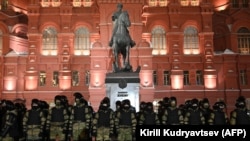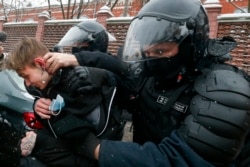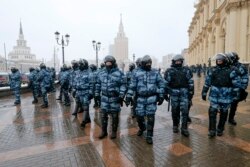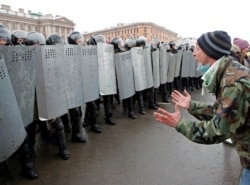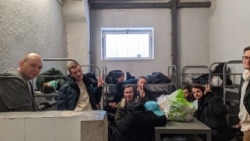On Tuesday, February 2, Russian opposition leader Alexey Navalny was sentenced to serve 3 1/2 years in a penal colony over parole violations stemming from a 2014 money laundering case.
Counting time served under house arrest in 2014, Navalny is set to spend two years and eight months in confinement.
The European Court of Human Rights (ECHR) had earlier found his conviction arbitrary and unreasonable. On February 1, the day before Navalny was sentenced, the New York-based Human Rights Watch (HRW) noted there had been “two weeks of nationwide protests, record numbers of detentions, and police brutality” following Navalny’s January 17 arrest upon arriving back in Russian from Germany.
After Navalny’s sentencing, rallies were held outside the Moscow court where the hearing took place, and across Russia. The Moscow Times reported that more than 1,400 protesters were detained nationwide on February 2, the majority in Moscow.
Russian presidential spokesman Dmitry Peskov dismissed allegations that Russian security forces had engaged in repressive acts against protesters.
"There is no repression, there are measures taken by the police against violators of the law — against participants in illegal actions.”
He added that those detained by police and Russian National Guard members had either participated “voluntarily” or been “the victim of instigators who spread all sorts of calls to participate in illegal actions.”
Peskov’s claim there was “no repression” is false.
Russia uses various mechanisms to strip citizens of their right to peacefully protest. The Russian government has also explicitly targeted journalists for covering the events or commenting on social media.
The Committee to Protect Journalists (CPJ) reported that police detained, intimidated or harassed at least 122 journalists nationwide during January 31 protests in support of Navalny. Overall, 5,600 people were arrested across the country that day.
One of those detained in Moscow was journalist Nikolai Svanidze, who is a member of Putin's advisory Human Rights Council.
Svanidze told Radio Free Europe/Radio Liberty that he was at the protest as an observer and released from a police van only after a senior officer became aware of his council membership.
Moscow police also detained journalists Ivan Yegorov, of the YouTube political news channel Another Opinion, and Artyom Kriger, of the independent news website Sota.Vision.
Vladimir Kornev, chief editor of the Telegram channel Belgorod No.1, was taken into custody on January 30. He was sentenced to three days of detention on charges of organizing an unsanctioned event in the city of Belgorod.
Other journalists around the country received written warnings from police not to attend the demonstrations.
Roughly half as many incidents involving journalists occurred during the January 23 rally in support of Navalny than on January 31, the CPJ said, citing reports by media and the Professional Union of Journalists and Media Workers. (Navalny had been recuperating in Berlin after being poisoned while on a trip to Siberia.)
The police violence appeared to intensify on February 2.
In an incident caught on camera, police attacked Fyodor Khudokormov, of the YouTube channel Real View, who was wearing a yellow vest with “PRESS” inscribed on it.
The officer approached Khudokormov and struck him on the head with a nightstick, knocking him to the ground. Khudokormov said he intends to file a criminal complaint over the assault.
Journalist Dmitry Nikitin was detained while covering the February 2 protest despite wearing his press vest and displaying press credentials. According to HRW, he was detained overnight and fined for “interfering with traffic.”
The Russian Legal Information Agency, citing the Russian Union of Journalists, reported that eight journalists were detained on February 2, adding most were released after their identification documents were checked.
Tanya Lokshina, HRW’s Europe and Central Asia associate director, told Polygraph.info it was not uncommon for journalists in Russia to be detained alongside protesters simply for “being in the wrong place at the wrong time.”
But she said the arrest and sentencing of Sergei Smirnov, chief editor of the news website Mediazona, represents a sea change.
Smirnov was arrested on January 30, ostensibly for blocking a road during the January 23 protest, which he did not attend. He was later sentenced to 25 days in jail for sharing a joking tweet that said he looked like the singer of a Russian punk band who supports Navalny.
“Anyone that reads [the tweet] can see it includes no calls for participation in the protest,” Lokshina said. “It is actually unprecedented when an editor-in-chief gets charged and sentenced to administrative arrest.”
Lokshina said such cases, coupled with the historically high detention figures and degrading detention facility conditions, showed authorities are no longer “bothering to window-dress” their actions.
In turn, Russian authorities are increasingly violating the civil rights and liberties of Russian citizens.
“Russia’s constitution and human rights obligations protect the right to peaceful assembly,” Lokshina said.
However, Russian authorities have created a “de facto” permission-based system to exercise that right, which “runs contrary to Russia’s constitution and international obligations,” she added.
Article 31 of Russia’s constitution grants citizens the right to gather peacefully, and to hold meetings, rallies, demonstrations, marches and pickets.
Still, Russian authorities regularly refuse to grant citizens the right to exercise their constitutional rights. According to the New York-based Institute of Modern Russia, the right of assembly has been “severely limited” through “federal legislation, an array of regional and local regulations, and an opaque system of bureaucracy.”
“Today, there exists a web of criminal and administrative laws that punish participation in unsanctioned protests while also making it incredibly difficult for organizers to receive a permit for protests,” the institute said in a March 2020 report.
OVD-Info, an independent media project covering human rights and political persecution in Russia, analyzed the factors that led Russian authorities to ban permits for protests and rallies.
OVD-Info reported that authorities did not allow demonstrations to be held even when permission to hold them was sought in advance. They noted that authorities “as a rule” did not “disclose data that could clarify the scope of refusals and their causes.”
In 2012, Russia increased 150-fold the fines imposed on people participating in unsanctioned protests. In 2014, Russia made participation in unsanctioned rallies a criminal offense.
As noted by U.K.-based Amnesty International, a solitary offense is punishable by up to 14 days in administrative detention, and three violations within 180 days is punishable by up to five years in prison.
Legislation introduced by pro-Kremlin lawmakers in November 2020 is aimed at giving “the government even more instruments to muffle discontent and justify bans on mass gatherings,” RFE/RL reported.
Russian authorities have used coronavirus restrictions to ban protests. Despite a Supreme Court appeal to stop locking people up on minor offenses to help stop the spread of COVID-19, authorities continue to pack demonstrators into unsanitary facilities.
“The system is not able to digest this staggering number of detainees. They spend hours on end on cold buses, with no food, water, or sanitary facilities,” Lokshina told Polygraph.info. “They are delivered to detention facilities that are overcrowded and do not have conditions acceptable for holding people.”
A social media post said 28 detainees had been packed in a crowded, unsanitary cell with one toilet and insufficient bunks.
Lokshina said detainees were denied access to lawyers while in custody, and court hearings had become “a joke,” as defense attorneys were not always present.
The Berlin-based watchdog group Transparency International called for Navalny and other political prisoners to be released, writing that it is “completely unacceptable to use violence against those who express their views through peaceful public protest, exercising their constitutional right to peaceful and unarmed assembly.”




